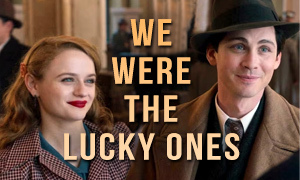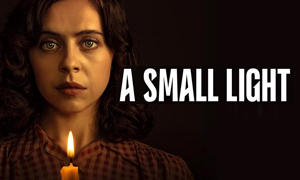Dunkirk: History vs. Hollywood
Is Tom Hardy's character Farrier based on a real person?
In the Dunkirk movie, the Royal Air Force pilot Farrier (Tom Hardy) engages in aerial battles to help prevent the Luftwaffe from assaulting the men stranded on the beach and sinking the boats in the water. In researching the Dunkirk true story, we discovered that while the character Farrier is not directly based on an actual person, his experience most closely resembles that of Alan Christopher "Al" Deere (pictured below), a New Zealand Spitfire pilot. Deere's plane was hit in the cooling system by the rear gunner of a German Dornier, and like Tom Hardy's character in the movie, Deere crash-landed on the beach. He landed wheels up on the water's edge and gashed his eyebrow in the process.
After a woman in a nearby cafe helped Al Deere with his bleeding eyebrow, he made his way to the soldiers waiting on the mole and eventually onto a ship. Many of the soldiers he encountered were angry, "Where the hell have you been?" they asked of the air force. Toward the end of the movie, RAF pilot Collins (Jack Lowden), is asked this by a soldier. Mark Rylance's character, Mr. Dawson, overhears and reassuringly tells Collins, "I know where you've been."
Did the soldiers on the beach really accuse the Royal Air Force of not doing enough to help them?
Yes, but it wasn't because the British airmen weren't helping. It was largely because most of the dogfights unfolded far from the beaches. This led the stranded soldiers, who were being strafed and bombed while awaiting rescue, to believe that the RAF wasn't doing enough to help. In the Dunkirk movie, it prompts a soldier on the beach to exclaim, "Where's the bloody air force!?"
When did the evacuation of Dunkirk take place?
The evacuation, code-named Operation Dynamo, took place on the beaches around Dunkirk, France from May 27 to June 4, 1940.
Why was the Dunkirk evacuation called Operation Dynamo?
In fact-checking the Dunkirk movie, we learned that Operation Dynamo was named after the dynamo room that generated electricity for the British Naval Headquarters located in the secret tunnels underneath Dover Castle. The tunnels are buried deep within the rock of the White Cliffs of Dover and are where the Dunkirk rescue was planned. The dynamo room contained a dynamo, an early electrical generator. The tunnels opened for tours in 2011.
Did Germany really drop propaganda flyers on the pinned down soldiers at Dunkirk?
Yes. The Germans dropped propaganda leaflets on the Allied soldiers who were cornered at Dunkirk. The closest example we could find to the menacing fictional flyer shown in the movie is pictured below on the left. The filmmakers appear to have dramatized it a little for the screen but the overall look is fairly close (minus the color). Other leaflets were dropped as well, some without graphics, that echoed a similar message. Some Dunkirk flyers even tried to convince the trapped soldiers that they would be treated humanely. "Do you really believe the nonsense, that Germans kill their prisoners? Come and see yourselves the contrary!" Of course, in many cases the Germans did execute their captives.
How did close to 400,000 Allied soldiers end up being pinned down at Dunkirk, France?
In September 1939, Germany invaded Poland by way of a blitzkrieg to start WW2, and the British Empire and France declared war on Germany. The British Expeditionary Force (BEF) went to France to help the country defend against the Germans, who invaded the Netherlands and Belgium on May 10, 1940. At the same time, three German Panzer corps pushed rapidly into France through the rugged terrain of the Ardennes Forest. The German Blitzkrieg ("lightning war") drove British, French and Belgian forces west and northward toward the English Channel. Hitler's sights were set on eliminating the retreating Allied forces that soon found themselves pinned down at Dunkirk with nowhere to go. -Daily Mail Online
Did the British Admiralty really give the order that private boats were to assist in the evacuation of Dunkirk?
Yes. On May 14, 1940, the BBC delivered a nationwide announcement from the British government: "The Admiralty have made an order requesting all owners of self-propelled pleasure craft between 30ft and 100ft in length to send all particulars to the Admiralty within 14 days from today if they have not already been offered or requisitioned." The boats, which included everything from small boats to large pleasure yachts, were often manned by the members of the Royal Navy. However, while exploring the Dunkirk true story, we learned that in many cases, due to a shortage of naval personnel, the owners of the boats took them to Dunkirk themselves. Some decided outright to captain their own boats like Mark Rylance's character Mr. Dawson does with his boat the Moonstone in the movie. In all, a total of about 700 private vessels assisted in the evacuation. They became known as the Little Ships of Dunkirk and were largely used to ferry soldiers out to the bigger boats that could not get close to the beach.
Interestingly, one of the private boats, a 62ft naval pinnace named Sundowner, was skippered by Charles Lightoller, the highest ranking officer to have survived the sinking of the Titanic in 1912. Lightoller had also commanded a destroyer during World War I.
How far away is Dunkirk, France from Great Britain?
Located at the northern tip of France near the border with Belgium, Dunkirk sits on the English Channel at one of the waterway's narrowest points. This allowed British rescue vessels, including private boats and yachts, to reach France in less time. Most of the evacuation boats departed from Dover, England. Three evacuation routes were used, with the shortest being 39 nautical miles and taking roughly 2 hours to reach the stranded soldiers on the beaches. On a side note, the closest point across the English channel is 20.7 miles and is just south of Dunkirk at Cap Gris Nez, a cape near Calais in the French département of Pas-de-Calais. From there, one can see the White Cliffs of Dover across the English Channel's Strait of Dover.
Were mines really a concern for the evacuating vessels?
Yes. Fact-checking the Dunkirk movie revealed that one of the three evacuation routes across the English Channel was so heavily mined that it could not be used at night. Despite Britain utilizing 36 minesweeping ships (one such vessel is pointed out in the film), mines still sunk or damaged a number of boats.
Did the Royal Air Force (RAF) send fighters inland to push back Germany's aerial assault on the beaches around Dunkirk?
Yes. RAF pilots like the fictional character Farrier (Tom Hardy) flew Spitfire and Hurricane fighters and attacked approaching German fighter planes in an effort to protect the Allied soldiers on the beaches until they could be rescued.
Had most of the town of Dunkirk been destroyed?
Yes. During our research into the true story behind the Dunkirk movie, we learned that German bombardment had left much of the town of Dunkirk in ruins as Nazi forces closed in. After the water supply was knocked out, fires burned uncontrollably. In an attempt to avoid the German aerial assault and put themselves in the best potential position for rescue, Allied soldiers hid in the sand dunes on the beaches.
Where can I learn about the eyewitness accounts that inspired the movie?
Joshua Levine, the historical consultant for the movie, wrote the book Dunkirk: The History Behind the Major Motion Picture, which explores the gripping true stories that inspired the Christopher Nolan film. The book relays eyewitness accounts that were shared by both veterans and civilians. It's definitely a worthwhile read, especially the parts that confirm the things that are seen in the film. The book draws largely from Levine's 2011 book, Forgotten Voices of Dunkirk, which is a collection of firsthand accounts that are both humorous and tragic. Director Nolan used Levine's Forgotten Voices in his research for the movie.
Did Christopher Nolan attempt to adhere strictly to the facts when writing the Dunkirk script?
No. In discussing the movie, Christopher Nolan explained why it's sometimes better to not adhere fervently to the facts. He embraced director Werner Herzog's idea of "ecstatic truth" in fiction. "It's the idea that fiction can communicate something more truthful to audiences about actual events than documentary," said Nolan. "By using fiction, I was able to explain various aspects of what happened in Dunkirk more efficiently and with more emotional clarity than by just following strict facts." -DGA Quarterly
Are the main characters in the movie based on real people?
No. Much in the same vein as Steven Spielberg's Saving Private Ryan, director Christopher Nolan chose to create fictional characters for his film. Some were inspired in part by actual eyewitness stories but were not slavishly based on real people. Nolan explained that he had first worked out "a precise mathematical structure" for the story, which involved telling it from three perspectives: the land (soldiers on the beach), the sea (boats assisting in the evacuation), and the air (fighter planes). The best way to maintain that structure was to create fictional characters who could be utilized freely for the greatest benefit of the story.
Did some of the men really try to either swim to the boats or across the English Channel?
Yes. Like the British soldier does in the movie, some of the men really did strip off their gear and try to make a lengthy swim toward the boats, while others went as far as trying to swim the English Channel, which was ultimately committing suicide. However, most men accepted their own limitations and opted to stay on the beach and wait for the "little ships."
Did the British really not send all of their destroyers and planes to help at Dunkirk?
In analyzing the fact vs. fiction in the Dunkirk movie, we discovered that Britain really did hold back some of their ships and planes from assisting at Dunkirk. They even called back some of their destroyers that were already there. Britain had a justifiable reason to do so. They wanted to be prepared for a German invasion of Britain and their primary means of defense was the Royal Navy. Regardless, they still lost significant numbers during the evacuation, including six destroyers and 145 planes.
How many soldiers were rescued during the evacuation of Dunkirk?
"There are 400,000 men on this beach," says Kenneth Branagh's character in the movie. Of those men, an estimated 338,000 Allied soldiers were rescued during the evacuation, which was officially known as Operation Dynamo. Prime Minister Winston Churchill and government officials had at first predicted that it would only be possible to rescue around 45,000 men before German forces blocked further evacuations. British citizens helped to shatter that estimate by offering their own boats to help assist in the Dunkirk rescue. It also helped that Hitler made the mistake of holding off a ground attack.
Did some soldiers really panic and try to rush the boats out of turn?
Yes, the Dunkirk movie true story confirms that things did become chaotic at times, with some soldiers who were waiting in line with their units desperately jumping out of line and making a dash for the boats. These soldiers were warned off at gunpoint. Men who were there recalled not being proud of such moments, but it was hard to resist when everyone was so desperate to survive.
How many British soldiers were killed during the evacuation of Dunkirk?
Approximately 11,000 British soldiers lost their lives during the evacuation from Dunkirk, also known as Operation Dynamo. An additional 40,000 soldiers were captured or imprisoned. In all, around 90,000 Allied soldiers were either wounded, killed or taken prisoner. -Daily Mail Online
How many boats were lost during the evacuation of Dunkirk?
The Germans destroyed 177 Allied aircraft and sunk more than 200 ships, including six British and three French destroyers. Still, the British managed to rescue approximately 338,000 soldiers from the beaches around Dunkirk, and Allied planes shot down 240 German aircraft.
Would Germany really have won WW2 if the evacuation from Dunkirk had failed?
The movie certainly makes this case, which adds to the intensity of the drama. History supports this assertion as well, with some historians calling it the defining moment of the 20th century. Had the approximate 338,000 rescued Allied soldiers been instead killed or taken prisoner by Germany, there would be that many less soldiers to return to Britain and continue fighting in Europe. So it's not hard to imagine the outcome of the war shifting in Germany's favor. At the time of the Dunkirk evacuation, the United States had not yet entered the war, and without the military might of Britain still in place, success on the European front would have been far less likely.
Why didn't Hitler send in ground troops to take out the pocket of Allied soldiers trapped at Dunkirk?
Though this has been a subject of debate among historians, many believe that the reason Hitler halted his ground forces was because of Nazi commander Hermann Göring, who was the head of the Luftwaffe, Germany's air force. Anxious to claim the glory of defeating the British, Göring convinced Hitler to allow the German air force to eliminate the Dunkirk pocket. It proved to be one of the greatest military blunders of WW2, as most of the trapped men escaped across the English Channel to Britain. It was evidence that air power alone could not single-handedly eradicate ground forces. -The German Blunder at Dunkirk
Hitler was also in favor of using the air force because he could preserve his tanks and men on the ground, which he had plans to direct elsewhere. James D'Arcy's character, Captain Winnant, echoes this in the movie when he says, "Why waste precious tanks when they can pick us off from the air like fish in a barrel." There was also a concern that the marshy ground around Dunkirk might be difficult for tanks. In addition, German ground forces needed time to rest and regroup after suffering heavy losses during the invasion of France.
Another theory was that Hitler held off sending in ground forces because he was showing compassion toward the British in hopes that Churchill would join Germany's fight against Russia. This far-fetched theory is not widely supported by historians, as Britain had already declared war on Germany on September 3, 1939 and Hitler would have little reason to believe Britain would ever switch sides. Furthermore, Hitler's Directive 13 contradicts this, as it called for the Luftwaffe to defeat the cornered Allied soldiers and prevent their escape.
Was Hitler's halt order the only reason German ground forces didn't reach more Allied soldiers waiting on the beaches?
No. The halt order, which was approved by Hitler and issued by the German High Command on May 22, 1940, was rescinded four days later on May 26. As we were fact-checking the Dunkirk movie, we discovered that one big reason so many Allied soldiers were able to make it off the beaches around Dunkirk was because of 40,000 soldiers of the French First Army, who were able to delay the Germans at the Siege of Lille from May 28-31. They battled seven German divisions, including three armored divisions. Winston Churchill called the First Army's effort a "splendid contribution," which hardly summed up its significance in allowing the British Expeditionary Force time to evacuate the beaches. When food and ammunition ran out, a surrender was negotiated and 35,000 men marched into captivity.
Other British and French rearguard units assisted in holding other areas of the perimeter as well, and in the end, it was mostly French soldiers who surrendered after covering the final Dunkirk evacuations.
Was Kenneth Branagh's character based on a real person?
It is likely that the movie's Commander Bolton (Kenneth Branagh) was inspired by the real-life Captain William Tennant, who arrived on the beaches of Dunkirk via the destroyer HMS Wolfhound. His assignment was to oversee the evacuation and organize the men waiting on the beaches. Like Commander Bolton in the movie, Tennant stayed right up until the last ships departed on June 2, 1940. He was heralded for his efforts at Dunkirk and was nicknamed "Dunkirk Joe" by the sailors under him. -BBC
William Tennant's noteworthy experiences in WW2 didn't end at Dunkirk. He was captain of the battlecruiser Repulse, which was sunk by the Japanese after a commendable campaign. Later as an admiral, Tennant was put in charge of naval transport for the Normandy invasion, which involved supervising the setup of two Mulberry harbors (portable harbors) for the rapid offloading of supplies during the invasion. He also oversaw the laying of the Pluto pipelines across the channel to send fuel supplies from England to France to support the Allied forces.
Did the soldiers who were rescued feel like they had let their country down?
Yes. There are reports of British soldiers boarding the evacuation ships and continually telling the crew that they had let their country down. The crew would reassure them that they had not. For many, it wasn't until they got back to Britain that they realized the country saw their survival as something worth celebrating.
Was the evacuation from Dunkirk considered a success?
Yes. British Prime Minister Winston Churchill described it as "a miracle of deliverance," inspiring him to declare to the House of Commons of Parliament on June 4, 1940, "We shall fight on the beaches, we shall fight on the landing grounds, we shall fight in the fields and in the streets, we shall fight in the hills. We shall never surrender!" However, in the same speech, Churchill also cautioned, "We must be very careful not to assign to this deliverance the attributes of a victory. Wars are not won by evacuations."
Have there been any other English-language feature films made about the WW2 Dunkirk evacuation?
Yes, just one, the 1958 British war movie Dunkirk starring Richard Attenborough, John Mills and Bernard Lee. That film was based on two novels about Operation Dynamo, Elleston Trevor's The Big Pick-Up and Lt. Col. Ewan Hunter and Maj. J. S. Bradford's book Dunkirk. Its story is told primarily from the perspectives of two characters, a newspaper reporter named Charles Foreman (Bernard Lee) and a soldier named Corporal "Tubby" Binns (John Mills). The reporter ends up taking out his own private boat to help aid in the Dunkirk rescue. Watch the Dunkirk 1958 movie trailer.
Was the Christopher Nolan film actually shot in Dunkirk, France?
Yes. While investigating the Dunkirk true story, we learned that the movie was actually filmed on location in Dunkirk, France, as well as several other locations, including Urk, Netherlands; Dorset, United Kingdom; and Rancho Palos Verdes, United States. The evacuation in the film was shot at the same historical Dunkirk location where the real evacuation took place. Twelve boats used in the filming had actually taken part in the real Dunkirk evacuation.
Dunkirk Documentary & Movie Trailers
Dive deeper into the Dunkirk movie's true story by watching the videos below, including a documentary about the evacuation and the German blunders at Dunkirk.
Link-to-Learn More:







